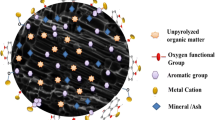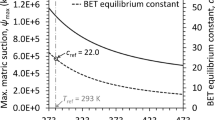Abstract
Desorption kinetics of benzene was investigated with a modified biphasic desorption model in a sandy soil with five different powdered activated carbon (PAC) contents (0, 1, 2, 5, 10% w/w) as sorbents. Sorption experiments followed by series dilution desorption were conducted for each sorbent. Desorption of benzene was successively performed at two stages using deionized water and hexane. Modeling was performed on both desorption isotherm and desorption rate for water-induced desorption to elucidate the presence of sorption–desorption hysteresis and biphasic desorption and if present to quantify the desorption-resistant fraction (q irr) and labile fraction (F) of desorption site responsible for rapid process. Desorption isotherms revealed that sorption–desorption exhibited a severe hysteresis with a significant fraction of benzene being irreversibly adsorbed onto both pure sand and PAC, and that desorption-resistant fraction (q irr) increased with PAC content. Desorption kinetic modeling showed that desorption of benzene was biphasic with much higher (4–40 times) rate constant for rapid process (k 1) than that for slow process (k 2), and that the difference in the rate constant increased with PAC content. The labile fraction (F) of desorption site showed a decreasing tendency with PAC. The experimental results would provide valuable information on remediation methods for soils and groundwater contaminated with BTEX.
Similar content being viewed by others
References
Abu, A., & Smith, S. (2005). Assessing sequestration of selected polycyclic aromatic hydrocarbons by use of adsorption modeling and temperature-programmed desorption. Environmental Science & Technology, 39, 7585–7591.
Abu-Salah, K., Shelef, G., Levanon, D., Armon, R., & Dosoretz, C. G. (1996). Microbial degradation of aromatic and poluaromatic toxic compounds adsorbed on powdered activated carbon. Journal of Biotechnology, 51, 265–272.
Alexander, M. (1995). How toxic are toxic chemicals in soil?. Environmental Science & Technology, 29, 2713–2717.
Alexander, M. (2000). Aging, bioavailability, and overestimation of risk from environmental pollutants. Environmental Science & Technology, 34, 4259–4265.
Baek, D.-S., Kim, S.-B., & Kim, D.-J. (2003). Irreversible sorption of benzene in sandy aquifer materials. Hydrological Processes, 17, 1239–1251.
Ball, W. P., & Roberts, P. V. (1991). Long terms of sorption halogenated organic chemicals by aquifer material, 2: Intraparticle diffusion. Environmental Science & Technology, 25, 1237–1249.
Berg, M. S., Loehr, R. C., & Webster, M. W. (1998). Release of petroleum hydrocarbons from bioremediated soils. Journal of Soil Contamination, 7, 675–695.
Brusseau, M. L., Jessup, R. E., & Rao, P. S. C. (1990). Sorption kinetics of organic chemicals: Evaluation of gas-purge and miscible-displacement techniques. Environmental Science & Technology, 24, 727–735.
Carroll, K. M., Harkness, M. R., Bracco, A. A., & Balcarcel, R. R. (1994). Application of a permeant/polymer diffusional model to the desorption of polychlorinated biphenyls from Hudson River sediments. Environmental Science & Technology, 28, 253–258.
Chen, Y. X., Chen, H. L., Xu, Y. T., & Shen, M. W. (2004). Irreversible sorption of pentachlorophenol to sediments: Experimental observations. Environment International, 30, 31–37.
Connaughton, D. F., Stedlinger, J. R., Lion, L. W., & Shuler, M. L. (1993). Description of time-varying desorption kinetics: Release of naphthalene from contaminated soils. Environmental Science & Technology, 27, 2397–2403.
Cornelissen, G., Van Noort, P. C., & Govers, H. A. J. (1997). Desorption kinetics of chlorobenzenes, polycyclic aromatic hydrocarbons, and polychlorinated biphenyls: Sediment extraction with tenax and effects of contact time and solute hydrophobicity. Environmental Toxicology and Chemistry, 16, 1351–1357.
Fu, G., Kan, A. T., & Tomson, M. B. (1994). Adsorption/desorption hysteresis of polycyclic aromatic hydrocarbons in surface sediment. Environmental Toxicology and Chemistry, 13, 1559–1567.
Gess, P., & Pavlostathis, S. G. (1997). Desorption of chlorinated organic compounds from a contaminated estuarine sediment. Environmental Toxicology and Chemistry, 13, 1598–1605.
Kan, A. T., Fu, G., Hunter, M. A., & Tomson, M. B. (1997). Irreversible adsorption of naphthalene and tetrachlorobiphenyl to Lula and surrogate sediment. Environmental Science & Technology, 31, 2176–2181.
Kan, A. T., Fu, G., & Tomson, M. B. (1994). Adsorption/desorption hysteresis in organic pollutant and soil/sediment interaction. Environmental Science & Technology, 28, 859–867.
Kim, D.-J., Choi, N., & Kim, S.-B. (2004). Quantification of irreversible benzene sorption in sandy materials. Hydrological Processes, 18, 3229–3234.
Kim, S.-B., Hwang, I., Kim, D.-J., Lee, S. J., & Jury, W. A. (2003). Effect of sorption on benzene biodegradation in sandy soil. Environmental Toxicology and Chemistry, 22, 2306–2311.
Kraaij, R., Ciarelli, S., Tolls, J., Kater, B. J., & Belfroid, A. (2001). Bioavaliability of lab-contaminated and native polycyclic aromatic hydrocarbons to the amphipod Corophium volutator relates to chemical desorption. Environmental Toxicology and Chemistry, 20, 1716–1724.
Lee, S. J., Kommalapati, R. R., Valsaraj, K. T., Pardue, J. H., & Constant, W. D. (2002a). Rate-limited desorption of volatile organic compounds from soils and implications for the remediation of a Louisiana superfund site. Environmental Monitoring and Assessment, 75, 87–105.
Lee, S. J., Moe, W. M., Valsaraj, K. T., & Pardue, J. H. (2002b). Effect of sorption and desorption resistance on aerobic trichloroethylene biodegradation in soils. Environmental Toxicology and Chemistry, 21, 1609–1617.
Lueking, A. D., Huang, W., Soderstrom-Schwarz, S., Kim, M., & Weber, W. J. Jr. (2000). Relationship of soil organic matter characteristics to organic contaminant sequestration and bioavailability. Journal of Environmental Quality, 29, 317–323.
McGroddy, S. E., & Farrington, J. W. (1995). Sediment porewater partitioning of polycyclic aromatic hydrocarbons in three cores from Boston Harbor, Massachusetts. Environmental Science & Technology, 29, 1542–1550.
Miller, C. T., & Pedit, J. A. (1992). Use of a reactive surface-diffusion model to describe apparent sorption–desorption hysteresis and abiotic degradation of lindane in a subsurface material. Environmental Science & Technology, 26, 1417–1427.
Nam, K., Chung, N., & Alexander, M. (1998). Relationship between organic matter content of soil and the sequestration of phenanthrene. Environmental Science & Technology, 32, 3785–3788.
Northcott, G. L., & Jones, K. C. (2001). Partitioning, extractability, and formation of nonextractable PAH residues in soil. 1. Compound differences in aging and sequestration. Environmental Science & Technology, 35, 1103–1110.
Park, J. H., Zhao, X., & Voice, T. C. (2001). Biodegradation of non-desorbable naphthalene in soils. Environmental Science & Technology, 35, 2734–2740.
Pavslostathis, S. G., & Jaglal, K. (1991). Desorption behavior of trichloroethylene in contaminated soil. Environmental Science & Technology, 25, 274–279.
Pavslostathis, S. G., & Mathavan, G. N. (1992). Desorption kinetics of selected volatile organic compounds from field contaminated soils. Environmental Science & Technology, 26, 532–528.
Pignatello, J. J. (1990). Slowly reversible sorption of aliphatic halocarbons in soils. 1. Formation of residual fractions. Environmental Toxicology and Chemistry, 9, 1107–1115.
Pignatello, J. J., Ferrandino, F. J., & Huang, L. Q. (1993). Elution of aged and freshly added herbicides from a soil. Environmental Science & Technology, 27, 1563–1571.
Pignatello, J. J., & Xing, B. (1996). Mechanisms of slow sorption of organic chemicals to natural particles. Environmental Science & Technology, 30, 1–11.
Opdyke, D. R., & Loehr, R. C. (1999). Determination of chemical release rates from soils: Experimental design. Environmental Science & Technology, 33, 1193–1199.
Steinberg, S. M., Pignatello, J. J., & Sawhney, B. L. (1987). Persistence of 1, 2-dibromoethane in soils: Entrapment in intraparticle micropores. Environmental Science & Technology, 21, 1201–1208.
ten Hulscher, Th. E. M., Vrind, B. A., ven den Heuvel, H., van der Velde, L. E., van Noort, P. C. M., Beurskens, J. E. M., & Govers, H. A. J. (1999). Triphasic desorption of highly resistant chlorobenzenes, polychlorinated biphenyls, and polycyclic aromatic hydrocarbons in field contaminated sediment. Environmental Science & Technology, 33, 126–132.
Williamson, D. G., Loehr, R. C., & Kimura, Y. (1998). Release of chemicals from contaminated soils. Journal of Soil Contamination, 7, 543–558.
White, J. C., Hunter, M., Nam, K., Pignatello, J., & Alexander, M. (1999). Correlation between biological and physical availabilities of phenanthrene in soils and soil humin in aging experiments. Environmental Toxicology and Chemistry, 18, 1720–1727.
Zhang, Y., Wu, R. S. S., Hong, H. S., Poon, K. F., & Lam, M. H. W. (2000). Field study on desorption rates of polynuclear aromatic hydrocarbons from contaminated marine sediment. Environmental Toxicology and Chemistry, 19, 2431–2435.
Author information
Authors and Affiliations
Corresponding author
Rights and permissions
About this article
Cite this article
Choi, JW., Kim, SB. & Kim, DJ. Desorption Kinetics of Benzene in a Sandy Soil in the Presence of Powdered Activated Carbon. Environ Monit Assess 125, 313–323 (2007). https://doi.org/10.1007/s10661-006-9524-y
Published:
Issue Date:
DOI: https://doi.org/10.1007/s10661-006-9524-y




